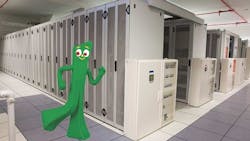5 Keys to Serving Enterprise and Hyperscale Customers Well (Spoiler Alert: Semper Gumby)
In this edition of Voices of the Industry, Chris Bair, Senior Vice President of Sales and Leasing at Stream Data Centers discusses 5 keys to successfully serving enterprise and hyperscale customers, including collaboration, adaptability, and flexibility.
Chris Bair, Senior Vice President of Sales and Leasing at Stream Data Centers (source: Stream Data Centers)
Enterprise and hyperscale requirements have converged; enterprises are looking for their data centers to be more cloud-like. That begs an interesting question: Is it possible for a data center built for enterprise customers to serve hyperscale customers (or vice versa)? To go a step further – could a data center be flexible enough to avoid the old ‘enterprise vs. hyperscale’ limitation altogether?
Broad requirements like TCO, flexibility, performance, and ‘righteousness’ are converging. But specific requirements – like topology (e.g. distributed v. block redundant), row lengths and amount of energy per row, blast radius/striping plans (how the equipment is laid out and how it’s powered), rack height, types of cooling (e.g. air-side economizers v. direct chilled water in-row), cage requirements/types, security and regulatory measures – do vary, between and among types of customers. Any more, there really isn’t a one-size fits all – for enterprises, or hyperscalers.
For hyperscalers, a data center provider that can meet specific requirements is essential because standardization across their global footprints is the key driver of their economies of scale. Given those specific needs, and the fact that cloud is the benchmark, is it possible to build data centers that serve these hyperscalers as well as enterprises? The answer is yes. And here, based on our experience, are the 5 keys to making it so.
#1: Be willing to collaborate
Enterprise and hyperscale markets are converging, but data center providers and their designs still have to be adaptable based on deployment or customer requirements. It’s about being able to change how we deliver in order to get the customer on board with good economics and reliability.
Customers are looking for data center providers that put steel on the ground; not a company that’s just buying a parcel or erecting an empty shell and advertising it as a data center. At the same time, they want a partner that’s agile to ensure their facilities have the flexibility necessary to accommodate specific customer requirements. That means a company that will customize (procedurally, operationally, structurally) to adapt to the client’s needs and will dig in with the customer at the beginning to understand the real drivers and explore the best fit solution. Data center providers should conform to customer rather than the customer conforming to you.
#2: Build in adaptability
Data center design is crucial, and that means you need to be able to design for flexibility. Data centers should be designed to be like an ideal pair of pants on Thanksgiving – super adjustable. Flexibility means the data center can support a single tenant occupying the entire space or securely serve several clients in the same facility. Even density must be adjustable to meet the requirements of enterprise vs. cloud users. As an example, our Chicago data center is 32 MW adjustable to 24 MW.
Other examples of built-in adaptability include:
- Single-level facilities, high clearance, stable delivery paths, etc. accommodate racks of different heights and weights over 4,000 pounds
- Options in how power is delivered – overhead, underfloor, RPP, busway – let our customers continue with their standard instead of being forced to adopt to ours
- Network is also eminently flexible; for example, customers can run dark fiber directly to their space in conduit without coming through an MMR
#3: Ensure flexibility over time
Customers want a partner with a track record of smart data center designs – with built-in adaptability – that stands the test of time. Still, flexibility to adapt as customers’ needs change is essential. For example, at one facility we successfully increased data hall density with no customer interruption. In a traditionally enterprise market we adapted the data center – expanding the utility power and the critical load – to suit a hyperscale customer’s needs.
#4: Make Goldilocks happy
Customers need to go fast. Speculative developers, like Stream Data Centers, are able to meet customers’ needs for speed to market. But it’s still important to be agile to meet customers’ particular requirements. It’s a balancing act to not be so flexible as to be pointless but flexible enough to meet the specific product, location, density, and deployment requirements. To able to serve those and still deliver a ton of value is key.
Basically, you need to aim to please Goldilocks. You don’t want to be just pure build-to-suit, because it typically takes too long for end users that need capacity ASAP. At the same time, you don’t want to be a company with just ‘spec’ capacity and an attitude of ‘we have what we have, take it or leave it’. It’s something in between. It’s just right.
For example, one customer asked us to reengineer our topology – from block redundant to distributed – to suit their preferred model. We were able to take what we had already built and convert the facility to distributed redundant efficiently and expeditiously with some smart design decisions by our team. One reason our team is able to strike that balance in design is their combination of enterprise, hyperscale, and colo experience.
#5: Recognize where you don’t need bespoke
Collaborating with customers doesn’t mean a good partner does whatever they say without adding their own critical thinking and perspective. (Critical thinking and perspective based on tenure and track record are, in fact, two of the reasons companies hire us.)
Collaboration and adaptability are key. You need to be willing to talk the customer out of customization that would hurt the economics of the project, though not at the expense of reliability.
Flexibility is key, but you also need to be reasonable. The ideal partner works hard to avoid the perverse incentive to overbuild, rather than use their extensive data center development experience to work with customers to deliver the most reliability and value possible.
Bottom line: Semper Gumby
For the Marines, Semper Gumby means Always Flexible. In the military, the combination of collaboration, built-in adaptability, and flexibility over time alongside a commitment to be rigid when necessary is essential to those most-critical missions. And in the data center industry, they’re essential to designing, building, and operating facilities that bypass the old ‘enterprise vs. hyperscale’ limitation altogether to best serve the unique – and changing – needs of all customers.
Chris Bair is Senior Vice President of Sales and Leasing at Stream Data Centers, which builds and operates for the largest and most sophisticated enterprises and hyperscale cloud providers – 24 data centers since 1999, with 90% of our capacity leased to the Fortune 500.


